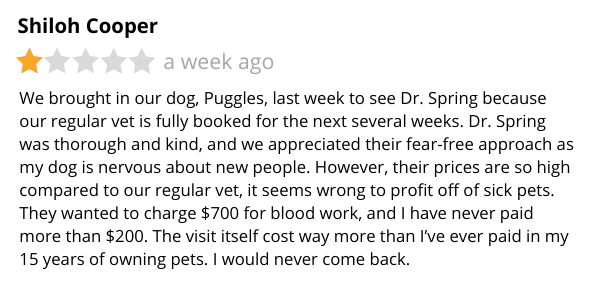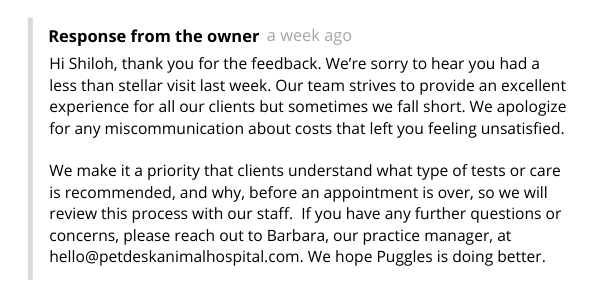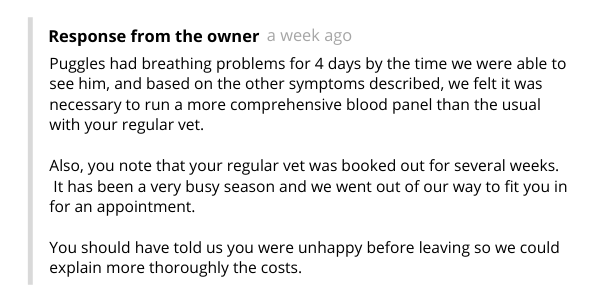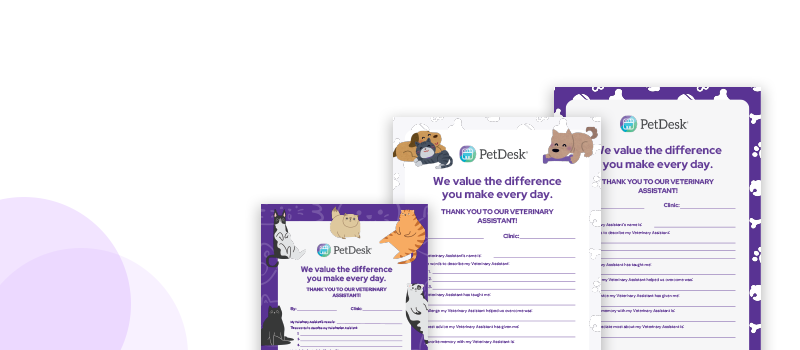We’ve spoken with many veterinary practice owners and managers stressed about their online reviews and how negative ones pop up disproportionately. Reviews tend to skew negative because those who have a negative experience are 21% more likely to leave a review than someone who had a positive experience.
The animal care industry is unique because of the emotional investment people have in their pets. It can lead to emotionally-charged bad reviews that are especially harmful and damaging for your business.
While a study showed that most people trust 4-star rated reviews, more and more people are looking at, and trusting, 1 to 2.5-star reviews to inform what could potentially go wrong for them at a business.
With 82% of people checking online reviews for local businesses, it’s vital to manage your reviews to ensure that your practice is represented fairly. Why does it matter? A healthy online reputation translates to a steady revenue flow from new clients choosing to trust you with their pet based on online reviews, and current clients being assured they’ve made the right decision to trust your practice.
The goal is, of course, to get a 5-star rating, but it’s challenging to maintain. Mistakes and miscommunications happen, and sometimes there are clients whose expectations can’t be met. The most important thing that matters is that you and your team are equipped with a strong strategy for handling these reviews.
Where to Monitor Reviews
There are a few different places online in which customers can submit reviews of your pet care business. Here are the online review sites that we recommend monitoring:
We recommend using Facebook as a tool to communicate with your customers because it’s the most popular social media site. It’s an especially good tool for you as a business because you can easily identify customers based on the information within their profile.
Because Facebook displays an individual’s full name, this limits the probability of someone posting fake reviews for malicious reasons. In cases where this does happen, the easiest way to counteract it is to double-check if that individual is actually a client at your business. If they are, you can proceed to deescalate the situation as you would normally. If you are unable to find them in your database, the best way to handle the situation is to respond that you were unable to find their information, and if they have any further issues they can contact you directly via phone.
Yelp
Yelp is one of the first resources a consumer refers to before trying a new establishment. This makes it a strong tool for small business owners to take advantage of and to harness all of those individuals early on in their search for a new pet care business. Yelp’s free features allow you to comment and respond to comments and reviews, in addition to monitoring your business traffic via the analytics page.
Google My Business
If you’re looking to increase your organic SEO (search engine optimization), listing your business on Google is an absolute necessity. Google rewards businesses that have higher star ratings with a higher search ranking.
Because Google’s ratings are directly tied with your search ranking in Google, it makes receiving positive reviews that much more important. Consider customer behavior when creating your strategy: what is the first thing that someone does when they look for information on the internet? Usually, the answer is “Google it.” We suggest leaning into this strategy as much as possible.
NextDoor App
NextDoor is a directory that’s verified based on a user’s address. The only people that are displayed in an individual’s feed are the people who live in the same designated neighborhood as the user.
This is a very powerful social networking tool for local pet care businesses to harness, as all of the reviews are tied to individuals who live within your neighborhood. We highly recommend monitoring this outlet because of how intimate the audience base is.
Best Practices for Responding to Reviews
Respond to the Good & Bad
Yes, we know that this is supposed to be about the bad reviews. However, make sure that you’re responding to positive ones as well so that all your clients feel heard. Most people are not expecting a response when it comes to positive reviews, so when you do respond to them, the reviewer will get a pleasant surprise.
Responding to all reviews, even the ones that are just a few words long, can be resolved with a simple “Hi Miriam, thank you for taking the time to review! We are glad that you noticed our focus on making curbside appointments as smooth as possible!”
This indicates to other people who are searching through customer reviews that you genuinely care about your clients’ feedback, and in turn, the quality of veterinary care that you provide.
Personalize Responses
While it may be easy to have a couple of canned responses to reviews, it’s important to treat every single review with care, and you can do that by personalization. Using the same response for every review can come off as disinterested or impersonal, so make sure to give each one some individual attention.
If possible, take the time to respond to something unique mentioned in the review. For example, if a review notes how nice the waiting room was or the attention to detail during the appointment, be sure to mention that in your response. Even better, if a pet’s name is brought up, be sure to include that within your response.
Here’s a good example of a personalized response from a good review:

Respond Quickly
When a customer leaves a review, they often don’t expect a response – they need a place to air their grievances or let their opinions be heard. However, when you DO respond to both good and bad reviews, customers are more likely to feel heard and valued. Aim to answer online reviews as quickly as possible – as soon as within the same day.
This can seem daunting with the thousands of other tasks that need to be accomplished, but there’s an easy way to get this done quickly. We recommend teaching multiple customer service representatives on how to handle online reviews so that you have more than one person working on it at one time. If multiple people take approximately 15 minutes every day to check on reviews, it will be less likely that a review falls through the cracks.
Elements of a Great Response to a Bad Review
Now that you know the best practices for review management, we’ll now go into the details of drafting a response to a bad review. As mentioned earlier, you don’t want to have the same response for each review. We recommend using this outline below to make sure you include the important elements and create some basic templates that can be used by your team.
Say Thank You
Bad reviews hurt and can even be just a list of exaggerations and half-truths written in anger. Whatever happened, this person took the time to share their experience, so the best way to start a response is acknowledging the effort it took to write the review. Here are some ways to do it:
- “Thank you for taking the time to share your experience.”
- “Thank you for the feedback.”
Apologize and Take Responsibility
Even if it was a simple misunderstanding or you are unable to verify the events, apologize. You can investigate what happened later, but for now, address the upset client’s experience and take responsibility. Though you are responding to the individual, others are reading your response and picking up cues about your practice’s level of service and care, so it’s important to show empathy no matter how tough it may be. Here is an example:
- “We’re sorry to hear you had a less than stellar visit last week. Our team strives to provide an excellent experience for all our clients but sometimes we fall short. We apologize for any miscommunication that left you unsatisfied.”
- “We’re sorry you did not have a good experience. We try our best to give our clients our full attention but it sounds like we weren’t able to do that for you.”
Express Your Good Intentions
Next, reaffirm your practice’s intentions and share the changes you’ll make based on the feedback, if any. Again, even if you are not at fault, there may be some things that your team can focus on or be more sensitive to going forward. An apology in itself doesn’t feel complete without expressing the willingness to change or take some action due to the situation. You can start with these for inspiration:
- “We will review our processes to make sure that all of our staff know to explain clearly why certain tests are recommended.”
- “We make it a priority to give clients great service, and unfortunately, on busy days, our phone wait times can get very long. We don’t like to put clients on hold, either, so we’re actively looking into ways to improve wait times.”
Next Steps
In some urgent cases, you may want to reach out to the client by phone and attempt to alleviate the situation. Otherwise, if appropriate, extend an invitation to take things off-line in your response. Even if they don’t take you up on the offer, it matters that you show a willingness to work things out with them.
Always avoid discussing specifics of a situation through online reviews. Instead, guide them towards a one-on-one setting via direct message or a phone call so you can work through the situation personally. Then you can connect them to the right individual and work out the best course of action to resolve the issue.
Here are some simple ways to do this:
- “Mindy, our practice manager, tried but was unable to reach you by phone. She’s eager to connect with you and can be reached at (555) 123-4567.”
- “If you have any further questions or concerns, please reach out to Barbara, our practice manager, at hello@petdeskanimalhospital.com.”
Get a Second Opinion
When it comes to pets, you’re talking about a part of the family, which can cause pet parents to leave reviews that are extremely challenging to receive and respond to. Whenever one of these reviews comes in, take a step back and distance yourself from the situation for 10-15 minutes. It’s good to get some perspective on a situation – especially when something is very emotionally charged.
We also recommend getting a second pair of eyes on the response to receive unbiased feedback on how your message may be perceived.
A Real-World Example of A Negative Review and Response
Here’s an example of a negative review and a clinic’s good and bad responses, inspired by real reviews and responses.

Do respond like this:

Why this is a good response:
Apologizing for the client’s experience of being caught off guard by the costs, not the costs themselves, is important. While the client had a good experience during the visit, the unexpected higher costs at the end left him unsatisfied overall, so the focus should be on that emotion. Regardless of who is really at fault, it is possible to apologize for someone’s bad experience.
Do not respond like this:

Why this is not a good response:
This response is similar to ones we’ve come across often: the clinic responds with their side of the story and shares the facts. While that is great for a crime investigation, prioritizing facts over showing empathy for the client’s experience does not make for a good review response. No matter how true, it comes off as cold and unkind.
Prospective clients reading bad reviews aren’t as interested in the facts as much as how you treat your current clients. No matter how unfair a bad review may be, taking some responsibility and keeping the door open for a conversation will allow your practice to repair relationships with those clients, while also showing the high standard of care for both people and pets.
Putting it into Practice
Armed with these tactics and a new outlook, you’re ready to put together a strategy for effectively managing your online reviews. Get your team on board and you’ll soon be on your way to improving your online reputation.
Your best weapon against negative reviews is having your satisfied clients leave good reviews! Read more about how you can proactively increase 5-star reviews.
Interested in learning more about how you can use proactive tactics to help improve client loyalty and increase revenue? Download our free e-book: The Customer Success Guide for Veterinary Practices!
Check out more best practices for veterinary professionals
Download a FREE copy of our customer success e-book! We’ve taken some of its key practices and created a guide for how the Customer Success Model can be applied to your practices.
See the power of PetDesk for yourself—for free
Save time and grow your business with custom websites and digital marketing, 24/7 error-free booking, a PIMS-VoIP phone system, plus a client engagement platform with a mobile app.










